Aging Effects in Zr(Fe0.5V0.5)2 Tritides
Abstract
1. Introduction
2. Materials and Methods
3. Results
4. Discussion
4.1. Hydrogen and Tritum: The Virgin Alloy
4.1.1. Solubility in the Alloy
4.1.2. Conversion into the Hydride Phase
4.2. Aging Effect
4.2.1. Helium Production–Release
- (1)
- The density of the alloy is calculated by the lattice parameters and, as pointed out by Spulak [4], the critical helium concentration strongly depends on the metal atom density;
- (2)
- The density of the helium atoms in a bubble weakly depends on the initial bubble radius as (r0)3/8, but changing the material also changes r0;
- (3)
- The number density of helium bubbles changes from metal to metal;
- (4)
- The release of helium also depends on the effective surface area of the alloy;
- (5)
- Finally, the presence of a large critical value can be argued for due to the particular structure of the alloy.
4.2.2. Tritium Release
A Solution Region
B Hydride-Forming Region
- (a)
- The ionization potential for He is higher than that for hydrogen; therefore, the capture of a tritium electron entering into the metal lattice is possible;
- (b)
- The capture of an electron of the d shell of the metal by He3 would decrease the d character of the metal, increasing the heat of formation [42], and favouring the conversion to hydride, which is not what we observed;
- (c)
- Increasing the tritium concentration would make more electrons available for He3 capture, thus hampering the hydride formation, as indicated by the decrease in ∆H.
5. Consequences to the Application of the Alloy
6. Conclusions
- The alloy shows a high critical value of He3 concentration (0.48) before it enters into the accelerated helium release rate phase; the reasons for this seems to reside in the lattice structure of the alloy and in the number of defects and impurities which form an elevated number of high-density helium bubbles;
- The study of tritium dissolution after 1500 days of aging suggests that He3 is mainly present as bubbles; the lattice sites where tritium dissolves relax close to their original configuration, slightly changing the enthalpy of solution; the number of sites available for the unit cell, however, reduces and therefore the equilibrium pressures increase;
- The He3 present in the interstitial site distorts the lattice of the alloy in such a way that tritium dissolved at infinite dilution turns out to be more tightly bound than hydrogen;
- The behavior of the thermodynamic parameters in the hydride-forming region is different than that in the solution region; however, the change in the nature of the tritium bond due to the presence of He3 is not sufficient to exhaustively explain this behavior;
- To minimize the residual inventory, tritium should reside in the alloy for no longer than a week.
Author Contributions
Funding
Data Availability Statement
Acknowledgments
Conflicts of Interest
List of Symbols
| (Ks)Q | temperature-dependent Sieverts’ constant Q = H, T |
| ∆ | enthalpy change at infinite dilution |
| ∆ | non-configurational entropy at infinite dilution |
| ∆ | non-configurational entropy |
| configurational entropy | |
| ∆H° | enthalpy for hydride formation |
| ∆S° | entropy for hydride formation |
| R | universal gas constant |
| H/A | hydrogen over alloy ratio |
| T/A | tritium over alloy ratio |
| He3/A | helium over alloy ratio |
| µQ | chemical potential for the Q atom Q = H or T |
| θ′ | hydrogen vibrational temperature |
Appendix A
- (a)
- nonconfigurational, or excess, entropy comprising vibrational electronic and magnetic contributions;
- (b)
- configurational entropy.
References
- Shmayda, W.; Kherani, N.; Ghezzi, F.; Bonizzoni, G. St 737 for Tritium Service—An experimental evaluation. Fusion Technol. 1992, 21, 1024–1029. [Google Scholar] [CrossRef]
- Ghezzi, F.; Venkataramani, N.; Conte, A.; Colombo, M.; Bonizzoni, G.; Shmayda, W.T. Isotopic Water Handling and Hydrogen Isotope Recovery for Fusion Application Using a Metallic Getter: I-Sorption and role of Hydrogen and Oxygen in the Batch Conversion Method. Fusion Technol. 1995, 27, 458–475. [Google Scholar] [CrossRef]
- Santucci, A.; Farina, L.; Tosti, S.; Novel, A.F. Non-Evaporable Getter Materials and Their Possible Use in Fusion Application for Tritium Recovery. Molecules 2020, 25, 5675. [Google Scholar] [CrossRef] [PubMed]
- Spulak, R.G., Jr. On Helium release from metal tritides. J. Less Common Met. 1987, 132, L17–L20. [Google Scholar] [CrossRef]
- Lässer, R. Properties of Helium-3 in Selected Metals in Tritium and Helium-3 in Metals; Springer: Berlin/Heidelberg, Germany, 1989; p. 112. [Google Scholar]
- Nobile, A.; Walters, R.T.; Wermer, J.R. Aging Effect in Palladium and LaNi4.25Al0.75 Tritides. Fusion Technol. 1992, 21, 769–774. [Google Scholar] [CrossRef]
- Santucci, A.; Incelli, M.; Noschese, L.; Moreno, C.; Di Fonzo, F.; Utili, M.; Tosti, S.; Day, C. The Isuue of Tritium in EMO colant and mitigation Strategies. Fusion Eng. Des. 2020, 158, 111759. [Google Scholar] [CrossRef]
- Klein, J.E.; Wilison, J.; Heroux, K.J.; Poore, A.S.; Babineau, D.W. Design option to minimize tritium inventory at Savannah River. Fusion Eng. Des. 2016, 109–111, 42–46. [Google Scholar] [CrossRef]
- Li, R.; Sun, Y.; Wei, Y. Aging effect in uranium tritide. Fusion Eng. Des. 2006, 81, 859–862. [Google Scholar] [CrossRef]
- Fukai, Y. Site preference of interstitial hydrogen in metals. J. Less Common Met. 1984, 101, 1–16. [Google Scholar] [CrossRef]
- Yvon, K. Structural aspects of ternary metal hydrides: A critical review. J. Less Common Met. 1984, 103, 53–70. [Google Scholar] [CrossRef]
- Nørskov, J.K.; Besenbacher, F. Theory of hydrogen interaction with metals. J. Less Common Met. 1987, 130, 475–490. [Google Scholar] [CrossRef]
- Westlake, D.G. Hydrides of intermetallic compounds: A review of stabilities, stoichiometries and preferred hydrogen sites. J. Less Common Met. 1983, 91, 1–20. [Google Scholar] [CrossRef]
- Jacob, I.; Shaltiel, D.; Davidov, D.; Miloslavski, I. A phenomenological model for the hydrogen absorption capacity in pseudobinary laves phase compounds. Solid. State Commun. 1977, 23, 669–672. [Google Scholar] [CrossRef]
- Lundin, C.E.; Lynch, F.E.; Magee, C.B. Relationships between intermetallic compound structure and hydride formation. J. Less Common Met. 1977, 56, 119–138. [Google Scholar]
- Shaltiel, D.; Jacob, I. Hydrogen absorption and desorption properties of AB2 laves-phase pseudobinary compounds. J. Less Common Met. 1977, 53, 117–131. [Google Scholar] [CrossRef]
- Boffito, C. (SAES Getters, Milan, Italy). Private communication, 2000.
- Pebler, A.; Gulbransen, E.A. Equilibrium Studies on the Systems ZrCr2-H2, ZrV2-H2 and ZrMo2-H2 Between 0° and 900 °C. Trans. TMS-AIME 1967, 239, 1593–1600. [Google Scholar]
- Shoemaker, D.P.; Shoemaker, C.B. Concerning atomic sites and capacities for hydrogen absorption in the AB2 Friauf-Laves phase. J. Less Common Met. 1979, 68, 43–58. [Google Scholar] [CrossRef]
- Didisheim, J.J.; Yvon, K.; Shaltiel, D.; Fischer, P. The distribution of the deuterium atoms in the deuterated hexagonal laves-phase ZrMn2D3. Solid. State Commun. 1979, 31, 47–50. [Google Scholar] [CrossRef]
- Lässer, R. Tritium and Helium-3 in Metal; Springer: Berlin/Heidelberg, Germany, 1989; p. 56. [Google Scholar]
- Wenzl, H. Properties and applications of metal hydrides in energy conversion systems. Int. Met. Rev. 1982, 27, 140–168. [Google Scholar] [CrossRef]
- McLellan, R.B.; Harkins, C.G. Hydrogen interactions with metals. Mater. Sci. Eng. 1975, 18, 5–35. [Google Scholar] [CrossRef]
- Haar, L.; Freeman, A.S.; Beckett, C.W. (Eds.) Ideal Gas Thermodynamic Functions and Isotope Exchange Functions for the Diatomic Hydride, Deuterides and Tritides; National Bureau of Standards Circ. No 37: Washington, DC, USA, 1961. [Google Scholar]
- Magerl, A.; Stump, N.; Wipf, H.; Alefeld, G. Thermodynamic aspects of hydrogen motions in dilute metallic solutions. J. Phys. Chem. Solids 1977, 38, 683–686. [Google Scholar] [CrossRef]
- Ghezzi, F.; Shmayda, W.T.; Kherani, N.P.; Bonizzoni, G. Zr(Fe0.5V0.5)2 for TRITIUM STORAGE: An Experimental Investigation, CFFTP Report I-9178. 2 October 1992.
- Kierstead, H.A. A theory of hydrogen absorption with interactions. J. Less Common Met. 1984, 96, 141–152. [Google Scholar] [CrossRef]
- Souberyuox, J.L.; Pontonnier, L.; Miraglia, S.; Isnard, O.; Fruchart, D.; Akiba, E.; Hayakawa, H.; Fujitani, S.; Yonezu, I. Structural Transformations in NiTi, a Potential Material for Hydrogen Storage. Z. Phys. Chem. 1993, 179, 225–236. [Google Scholar]
- Shante, V.K.S.; Kirkpatrick, S. An introduction to percolation theory. Adv. Phys. 1971, 20, 325–357. [Google Scholar] [CrossRef]
- Lewis, M.B.; Farrell, K. Migration behavior of helium under displacive irradiation in stainless steel, nickel, iron and zirconium. Nucl. Instr. Meth. 1986, 16, 163–170. [Google Scholar] [CrossRef]
- Lucas, A.A. Helium in Metals, Physica 127B. In Proceedings of the 4th General Conference of the Condensed Matter. Division of EPS, Hague, The Netherlands, 19–22 March 1984; pp. 225–239. [Google Scholar]
- Wilson, W.D.; Bisson, C.L.; Baskes, M.I. Self trapping of helium in metals. Phys. Rev. 1981, 24, 5616–5624. [Google Scholar] [CrossRef]
- Trinkaus, H. Energetics and formation kinetics of helium bubbles in metals. Radiat. Eff. 1983, 78, 189–211. [Google Scholar] [CrossRef]
- Nowick, A.S.; Burton, J.J. (Eds.) Diffusion in Solid; Academic Press: New York, NY, USA, 1975; p. 213. [Google Scholar]
- Flament, J.L.; Lozes, G. Localization de l’helium forme dans les composes trities. In Proceedings of the 3ème Congrès International Hydrogène et Matèriaux; Azou, P., Ed.; University of Boumerdes: Paris, France, 1982; Volume 3, pp. 173–178. [Google Scholar]
- Sakamoto, M. Study of Hydrogen Vibration in Transition Metal Hydride by Thermal Neutron Transmission. J. Phys. Soc. Jpn. 1964, 19, 1862–1866. [Google Scholar] [CrossRef]
- Boucour, V.P.; Percheron-Guegan, A.; Achard, J.C.; Gasnier, P.; Varriat, J.Y.; Limacher, B.; Leroy, D. EXAFS Study of the Aging of LaNi5 and LaNI4.5Mn0.5 Compounds during Tritium Storage. Z. Phys. Chem. 1994, 183, 109–116. [Google Scholar]
- McLellan, R.B. Phase Solubility in Metals and Alloys; Rudman, P.S., Stringer, J., Jaffee, R.I., Eds.; McGraw-Hill: New York, NY, USA, 1966; p. 415. [Google Scholar]
- Katz, L.; Guinan, M.; Borg, R.J. Diffusin of H2, D2 and T2 in Single-Crystal Ni and Cu. Phys. Rev. 1971, 4, 330–341. [Google Scholar] [CrossRef]
- Nagasaka, M.; Yamashina, T. Solubility of hydrogen and deuterium in titanium and zirconium under very low press. J. Less Common Met. 1976, 45, 53–62. [Google Scholar] [CrossRef]
- Knize, R.J.; Cecchi, J.L.; Dylla, H.F. Measurement of H2, D2 Solubilities in Zr-Al. J. Vac. Sci. Technol. 1982, 20, 1135–1137. [Google Scholar] [CrossRef]
- Mueller, W.M.; Blackedge, J.P.; Libowitz, G.G. Metal Hydrides; Academic Press: New York, NY, USA, 1968; p. 67. [Google Scholar]
- Chen, C.A.; Liu, L.; Wang, B.; Xiang, X.; Yao, Y.; Song, J. Assesment of tritiated activities in the radwaste generated from ITER Chinese helium cooled ceramic breeding test blanket module system. Fusion Eng. Des. 2016, 112, 569578. [Google Scholar] [CrossRef]
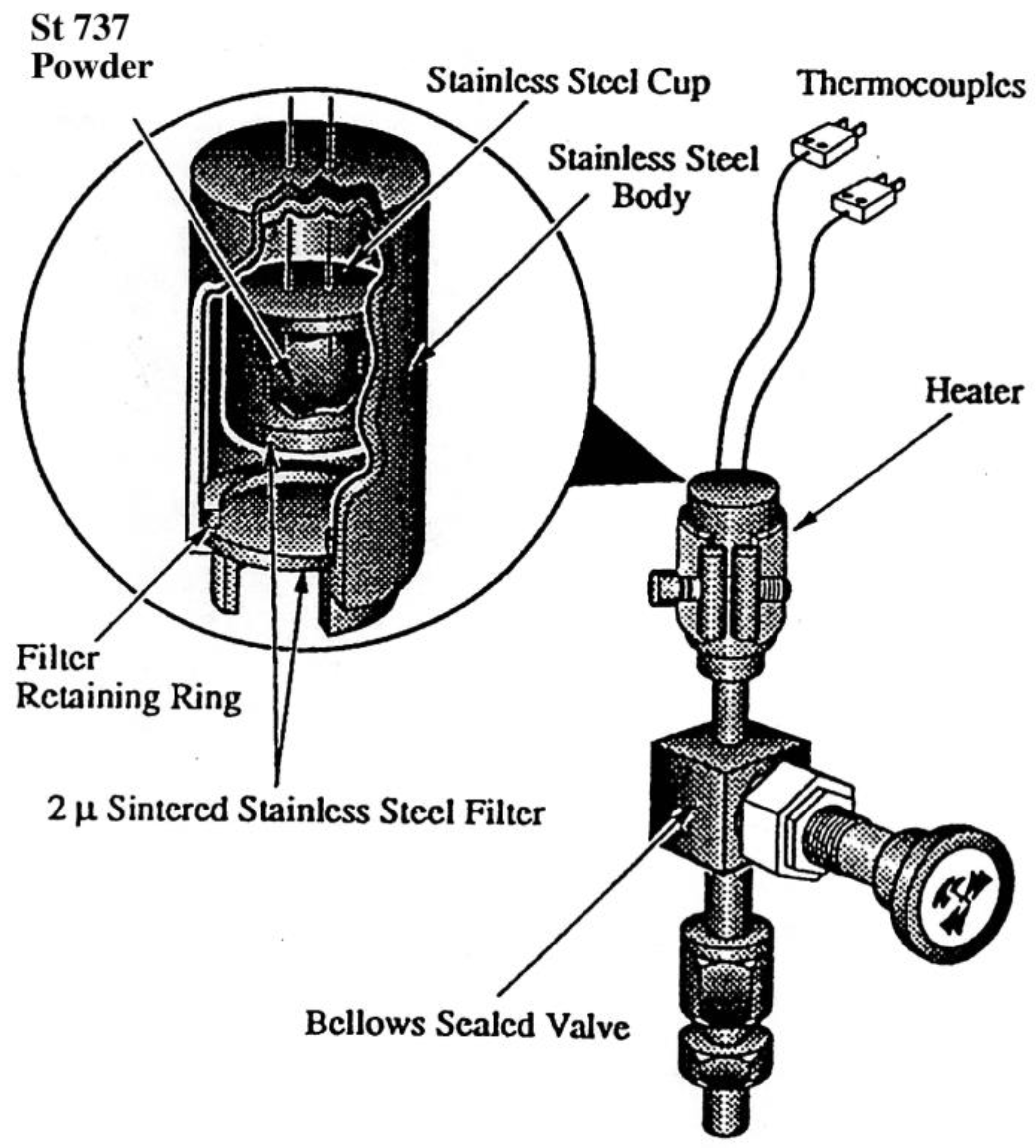



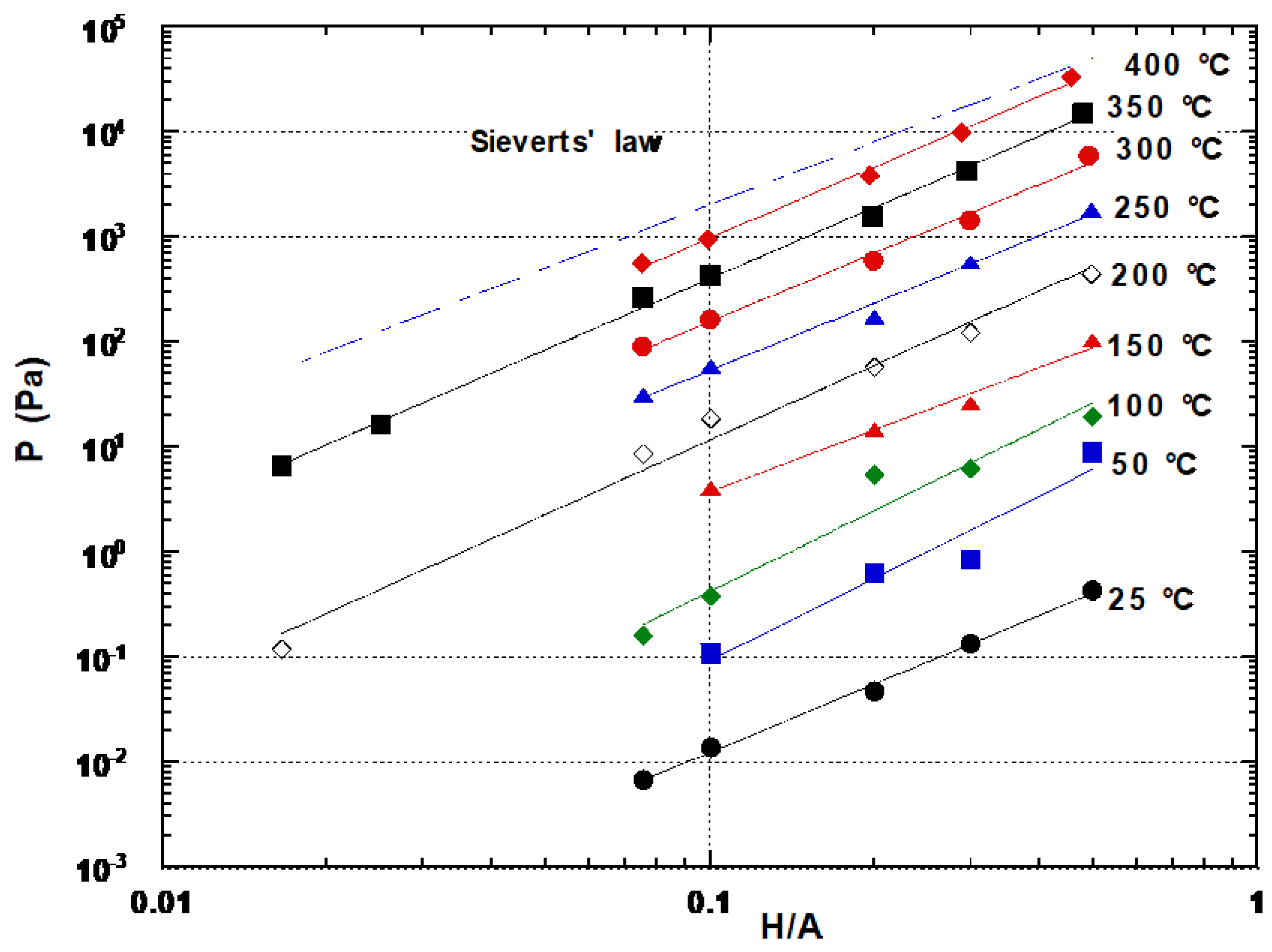

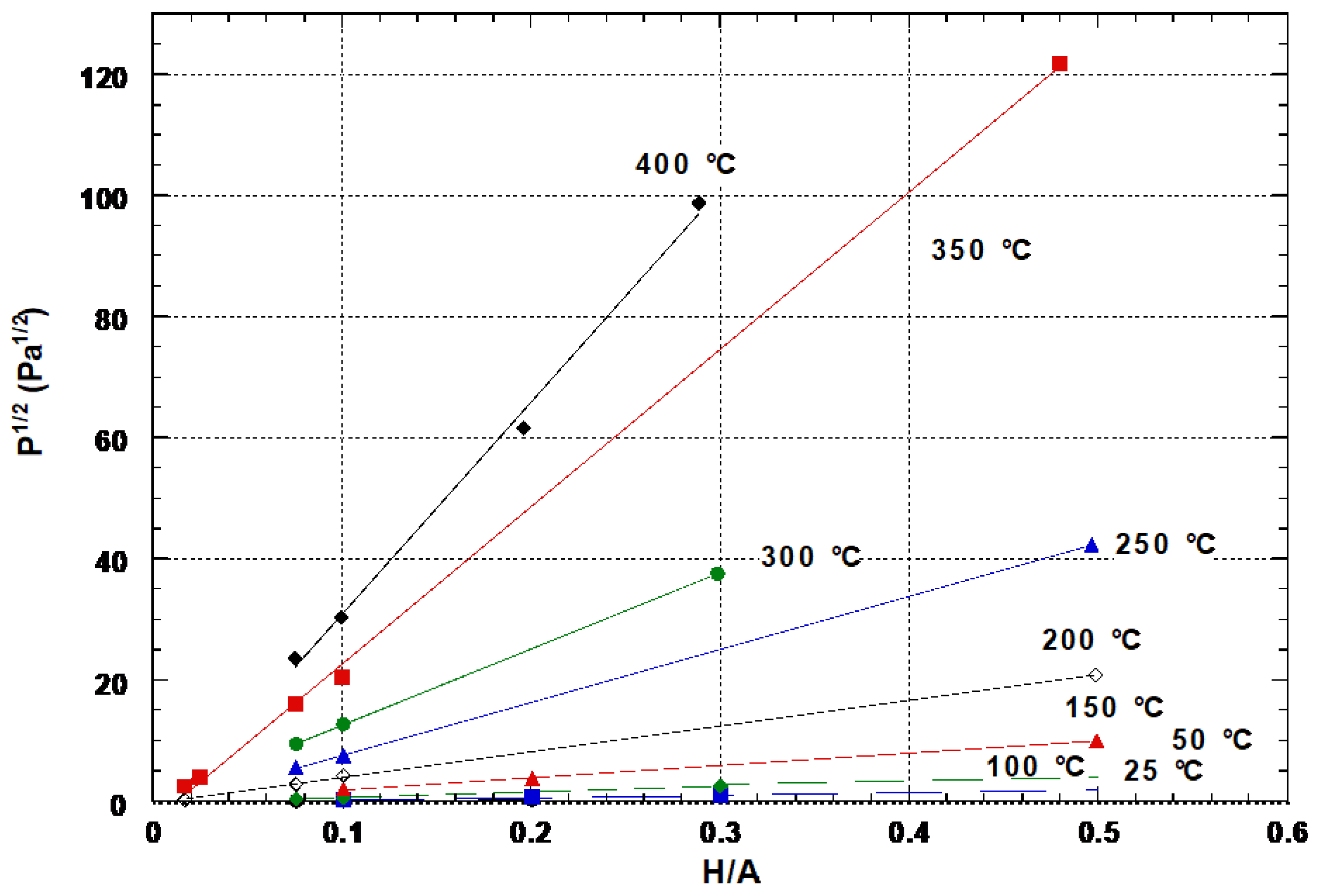
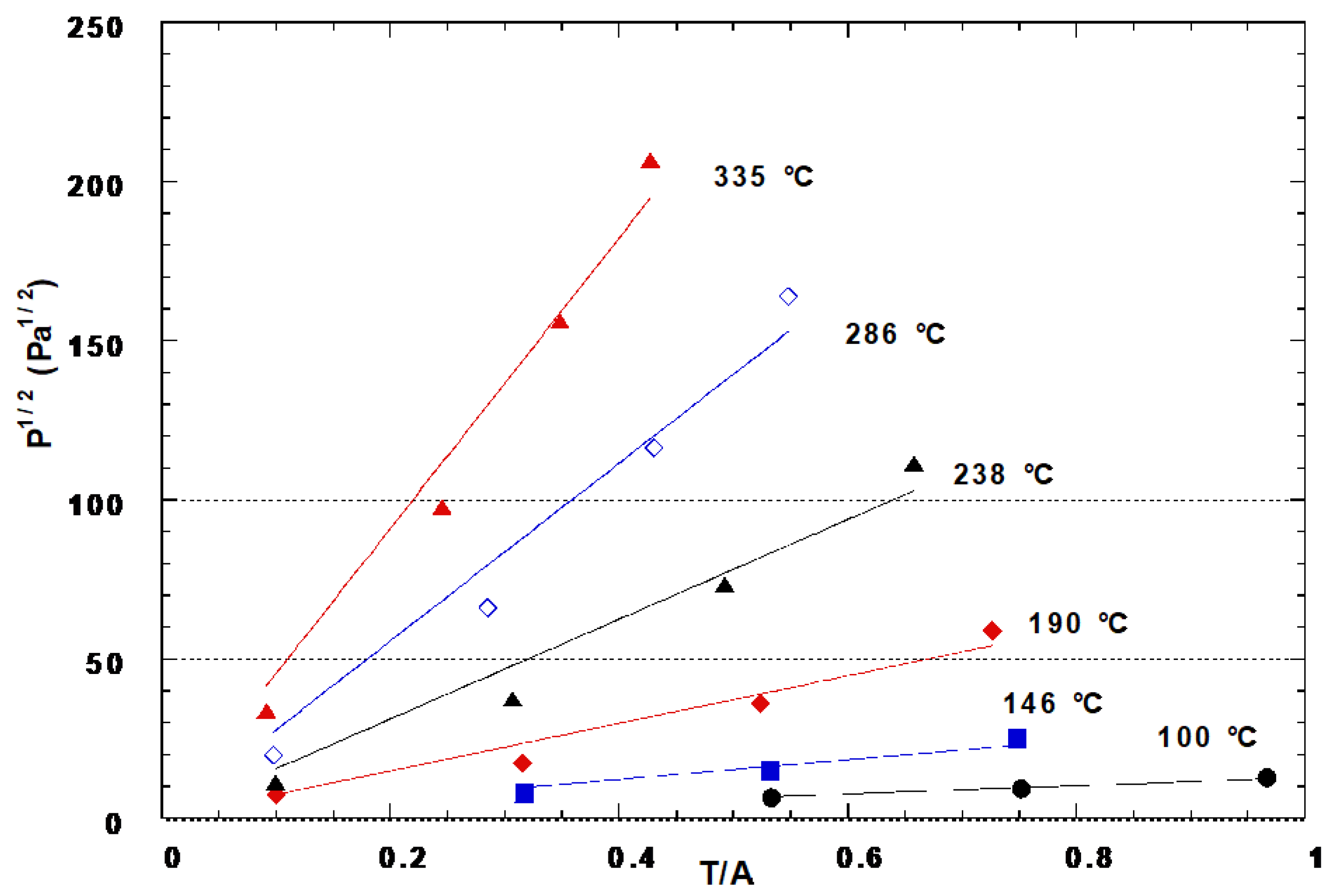
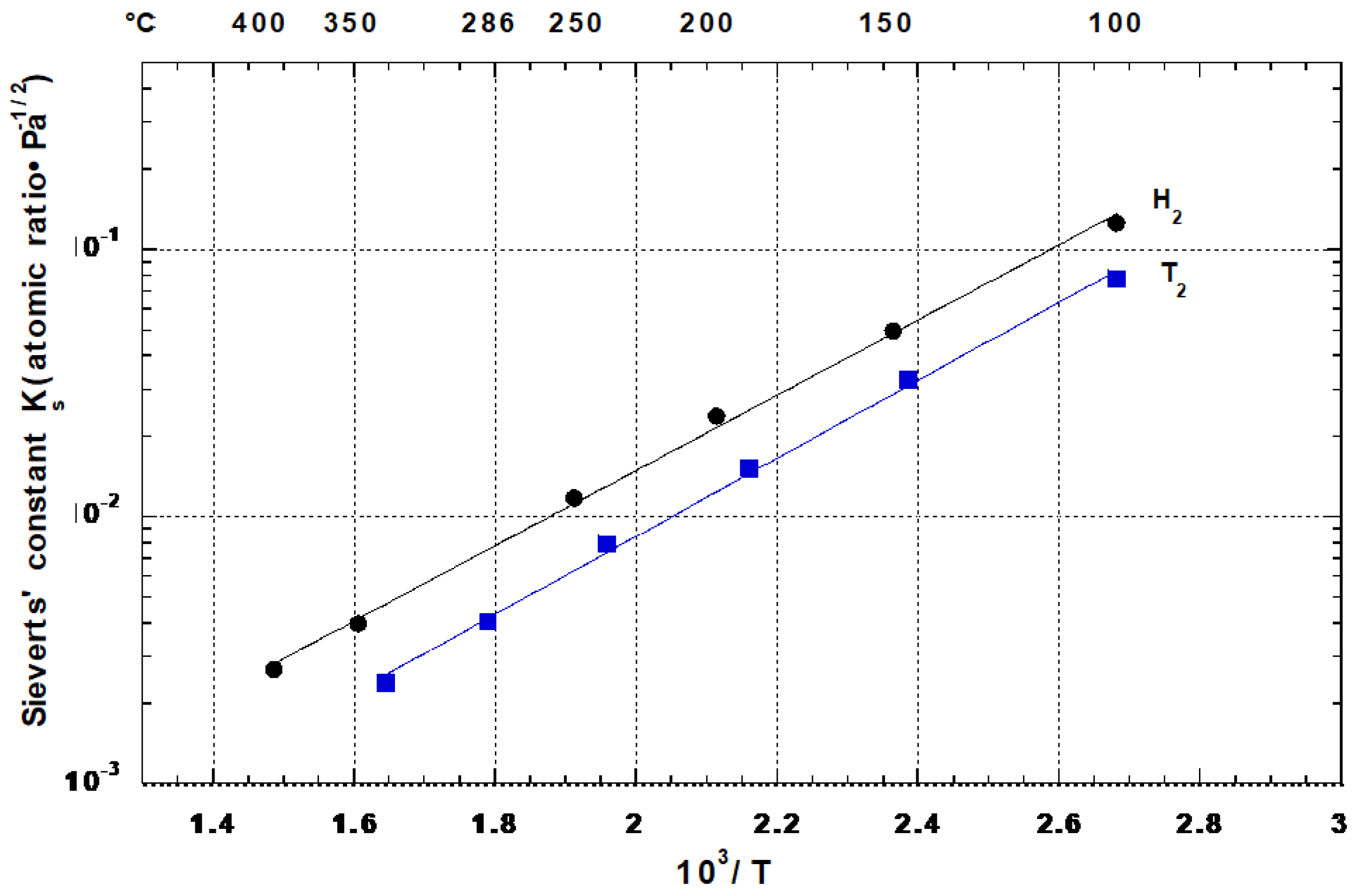
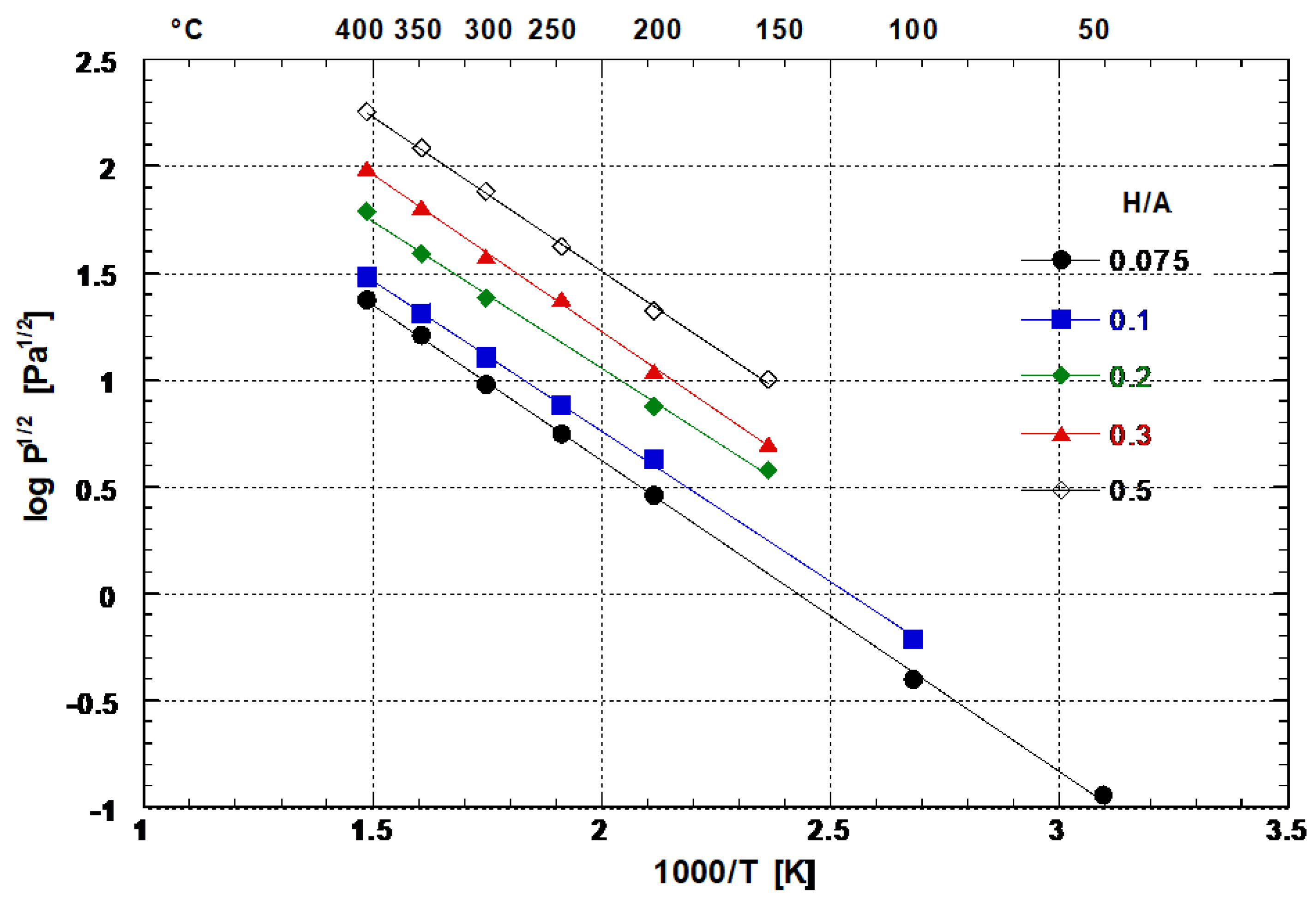
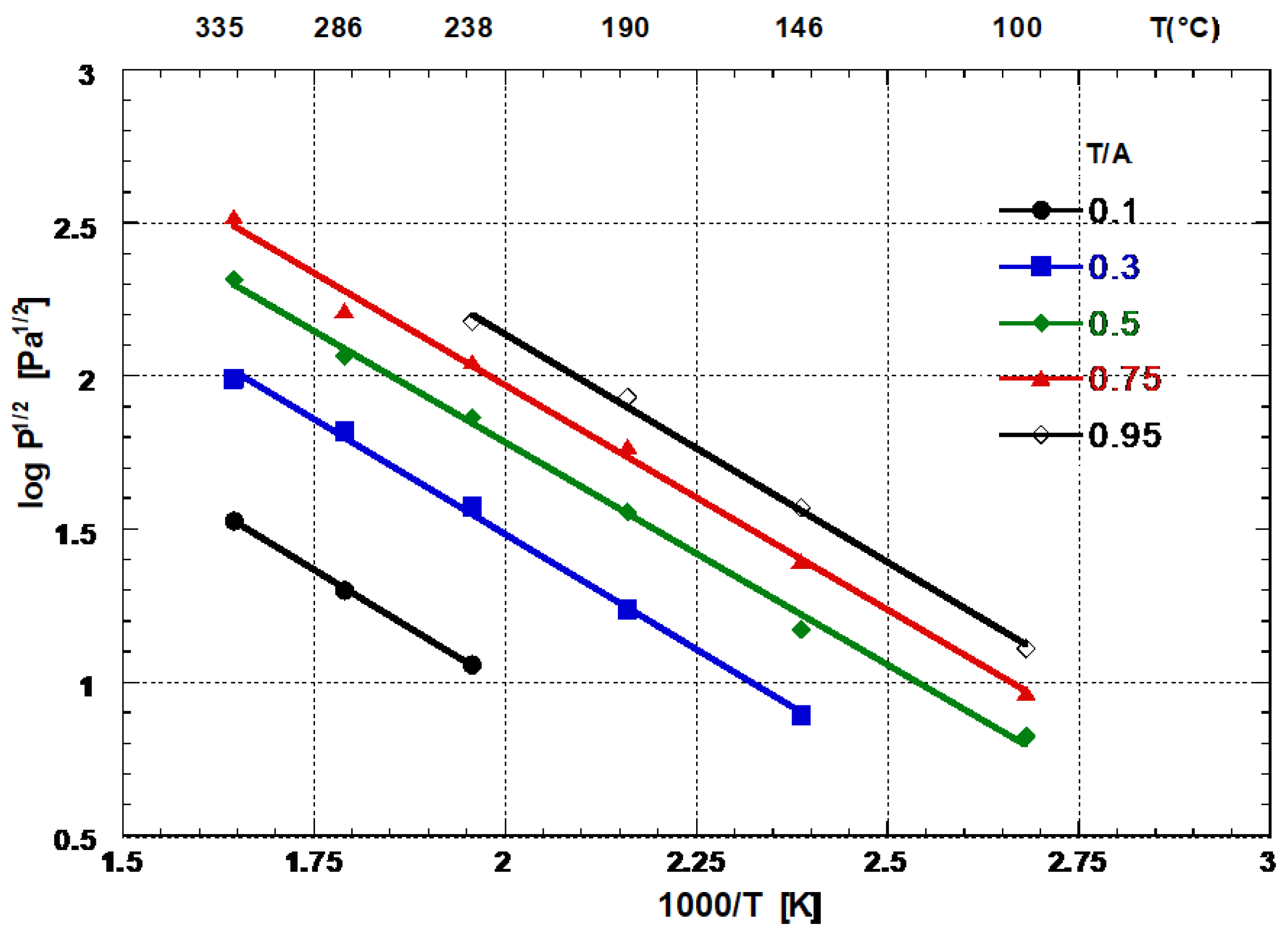
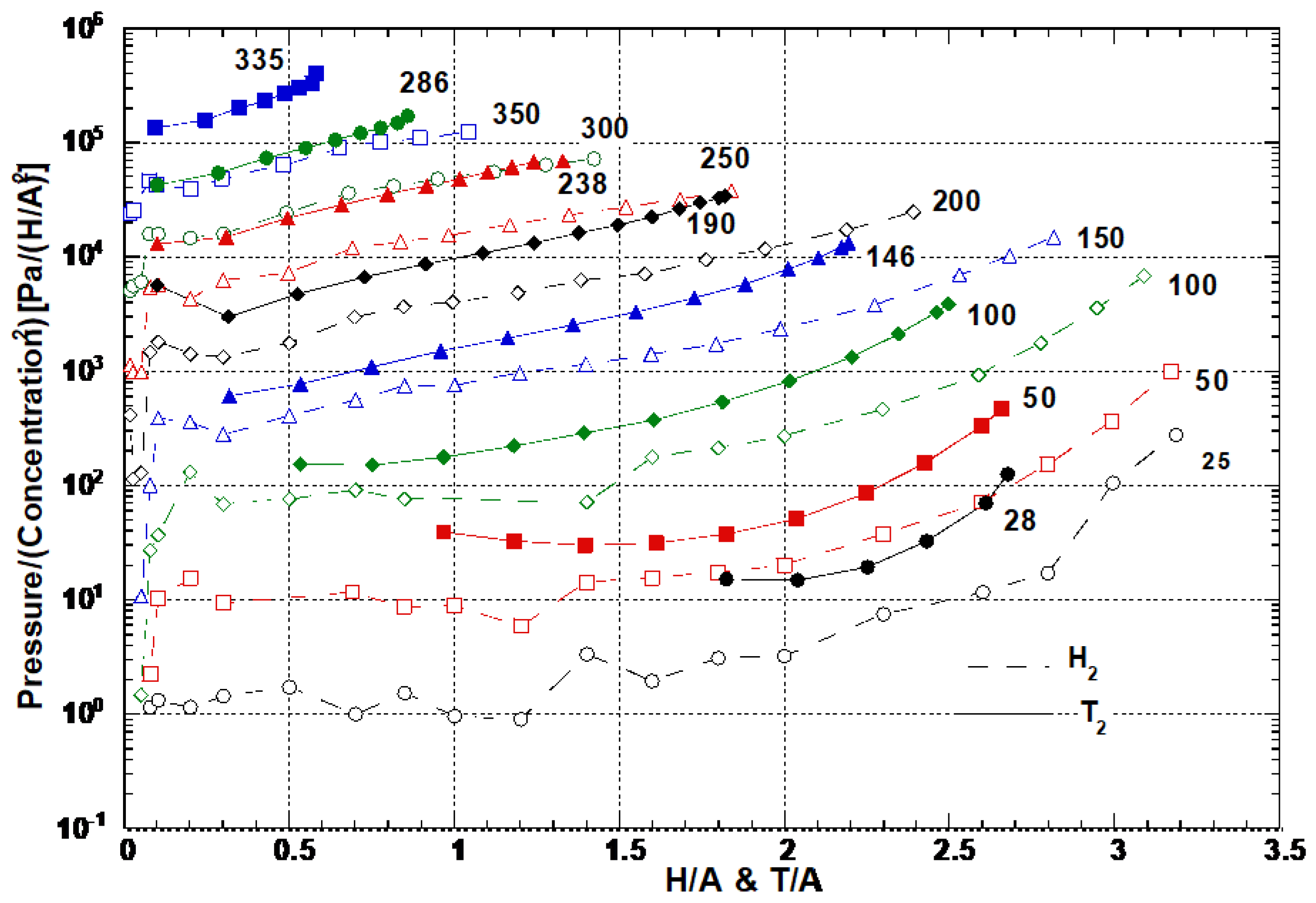

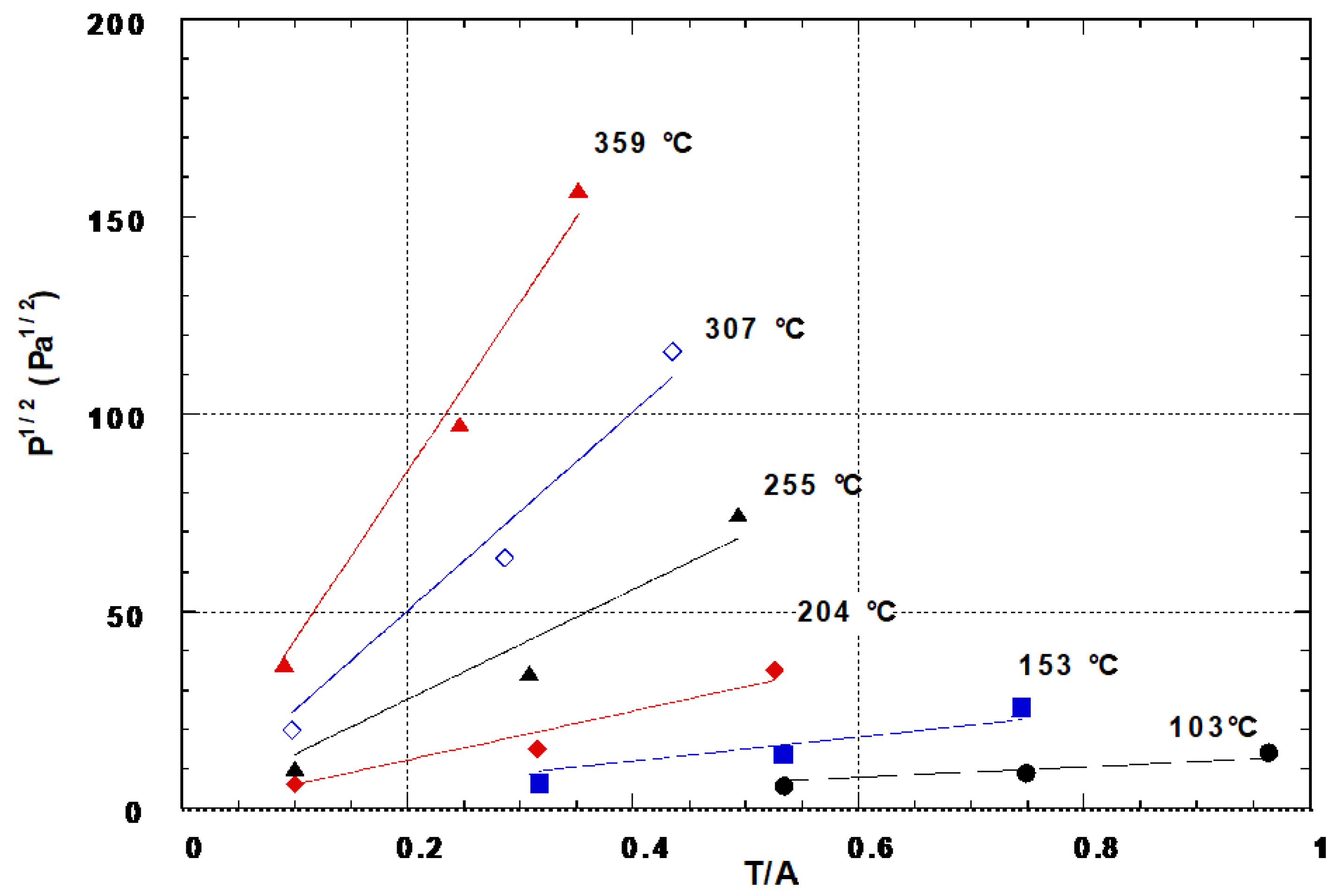
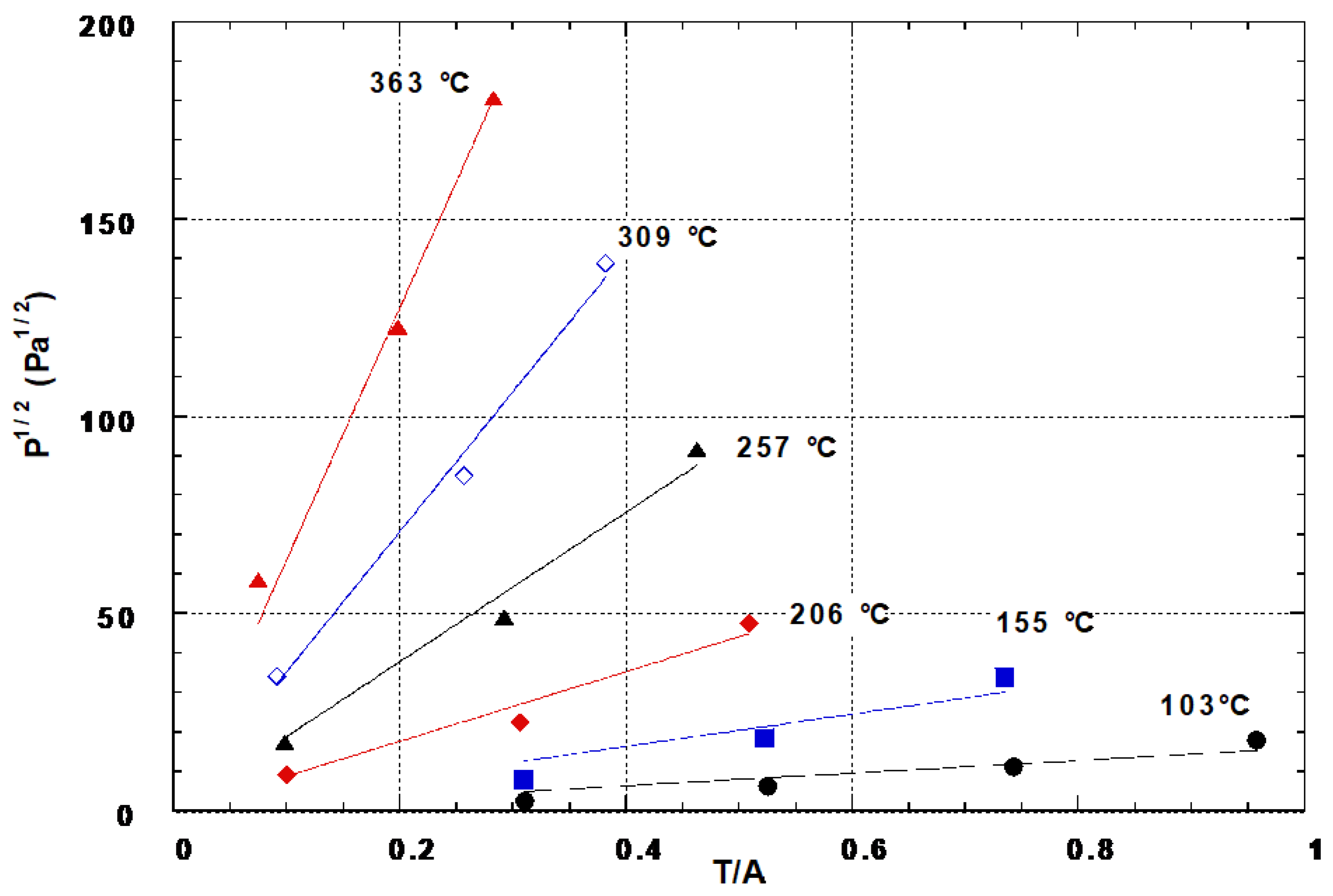
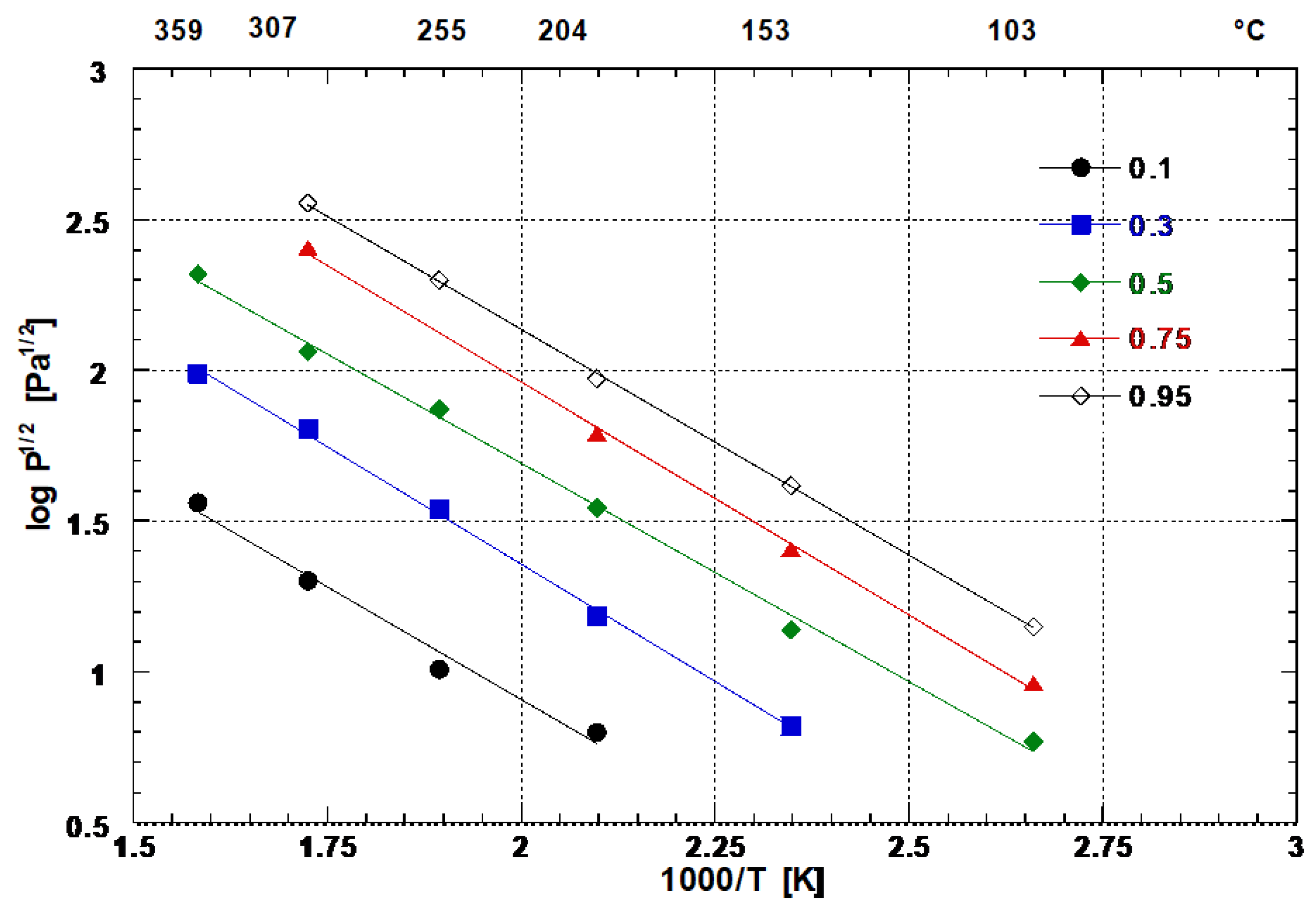
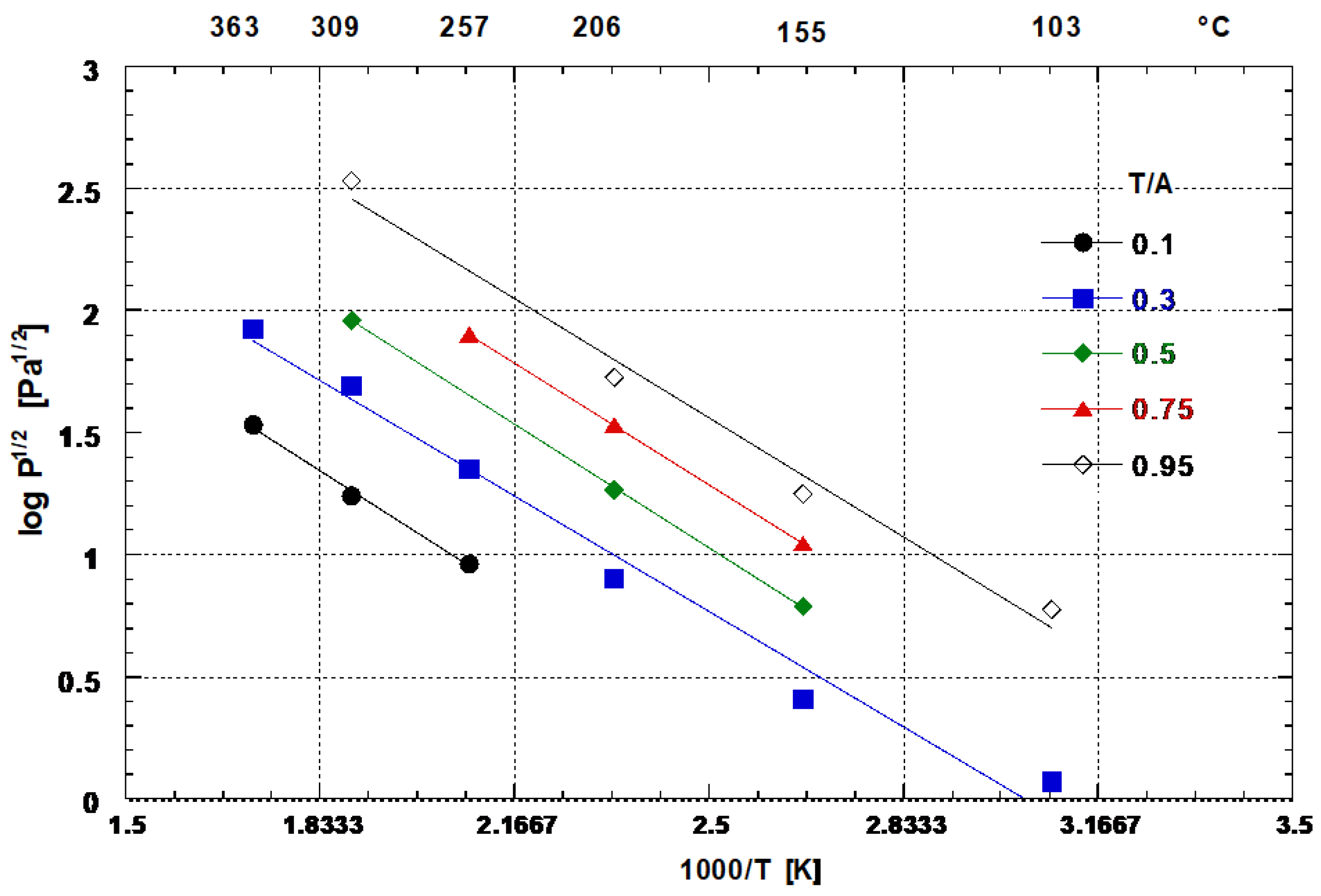
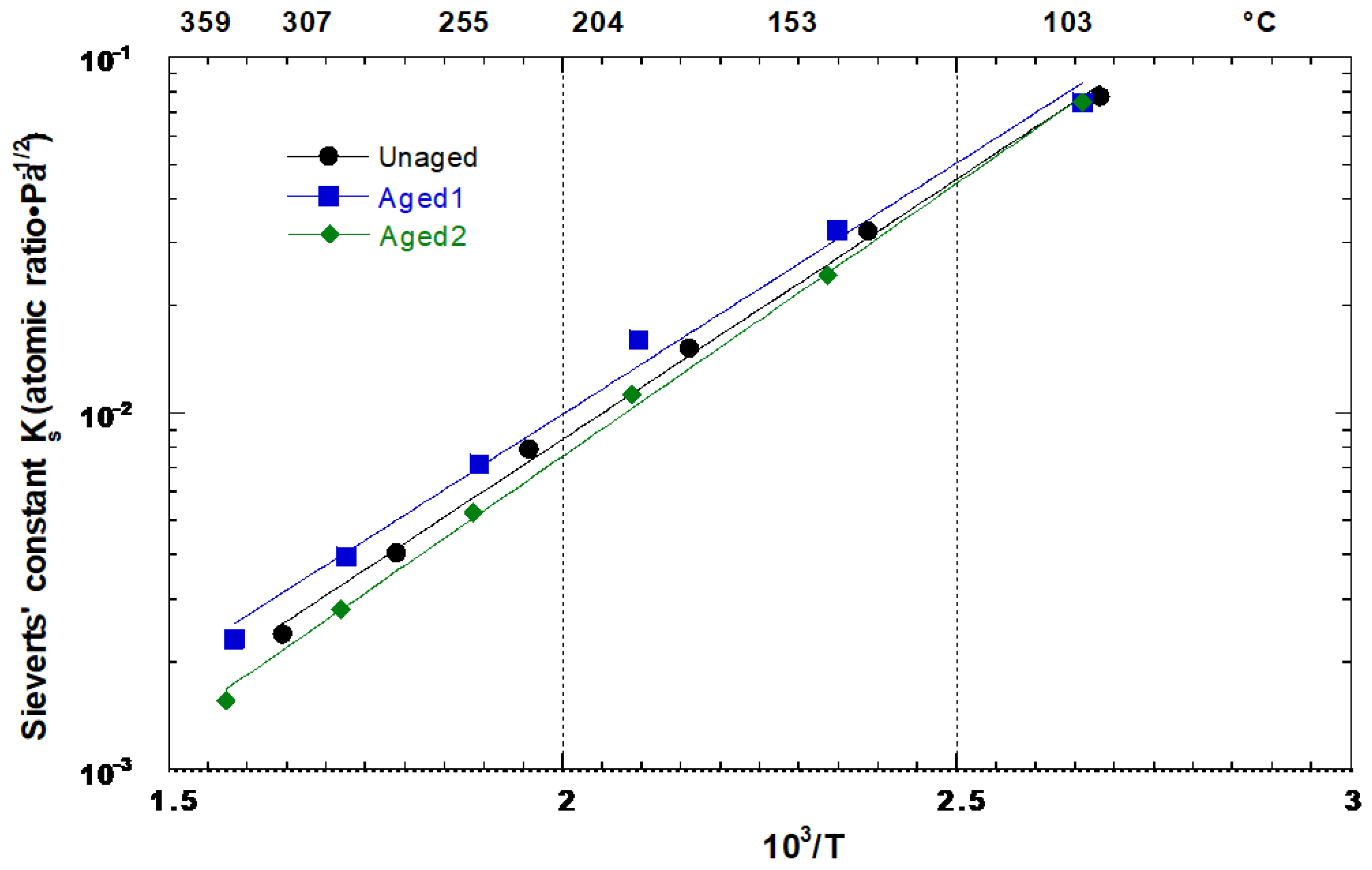
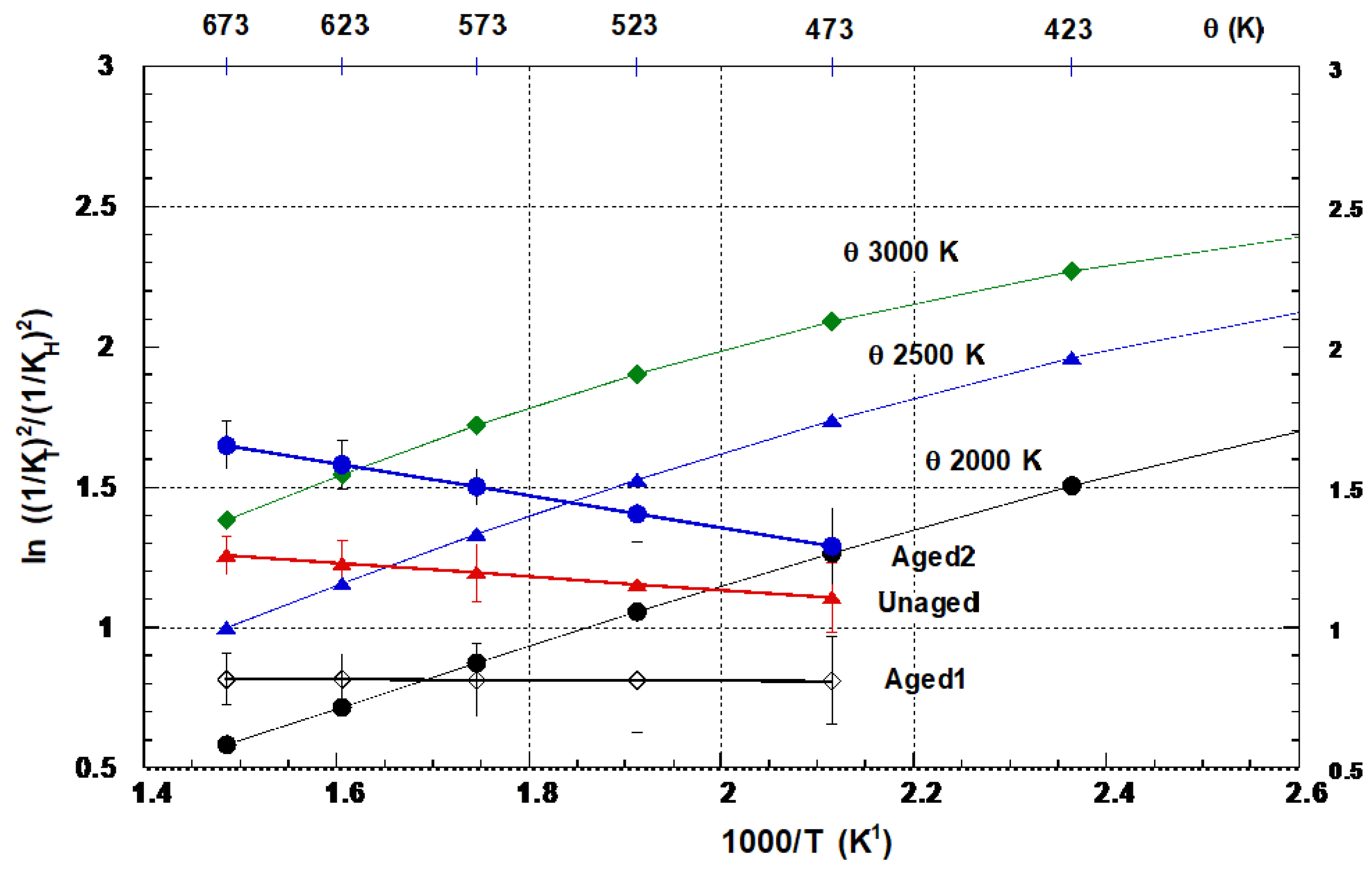
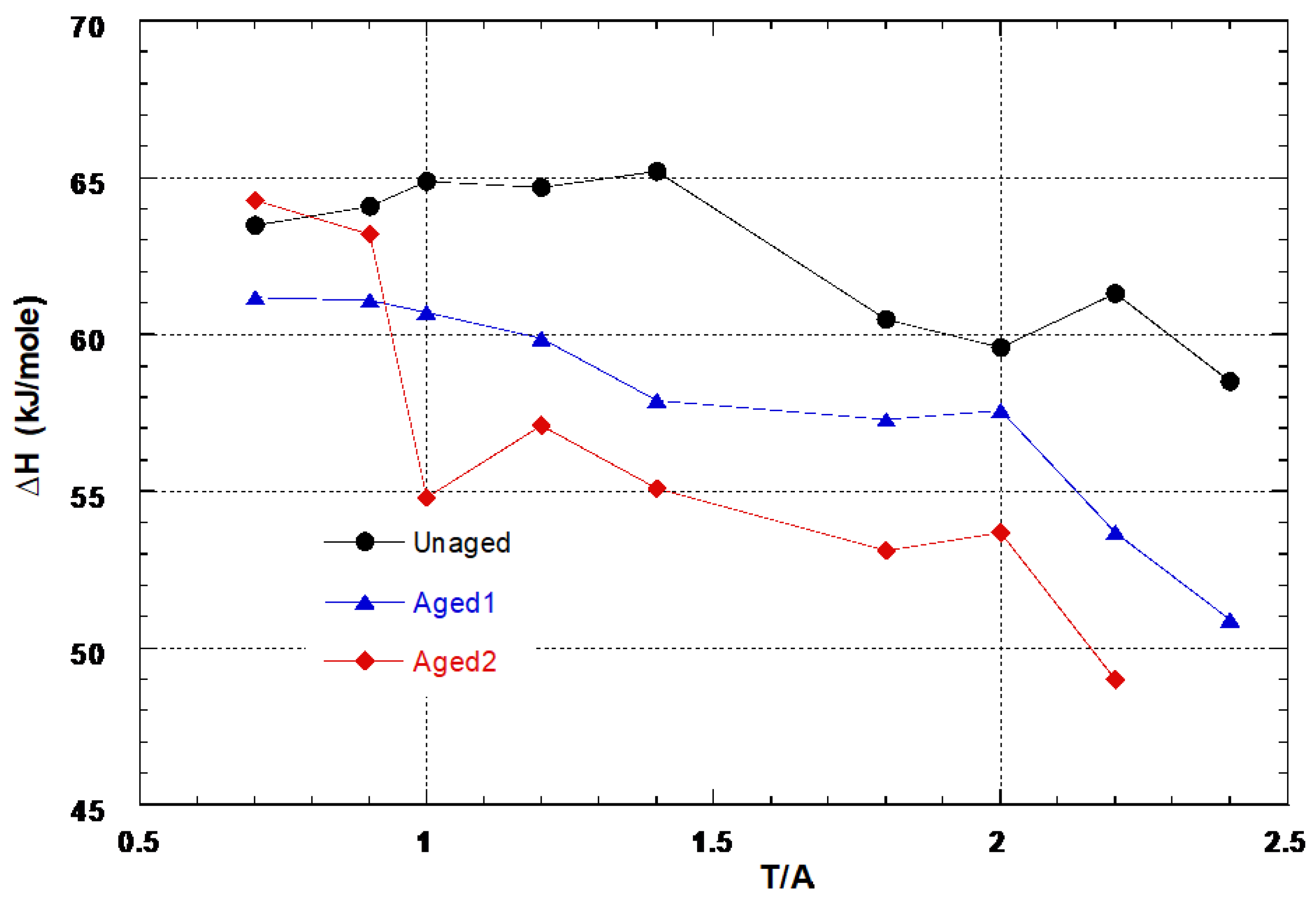
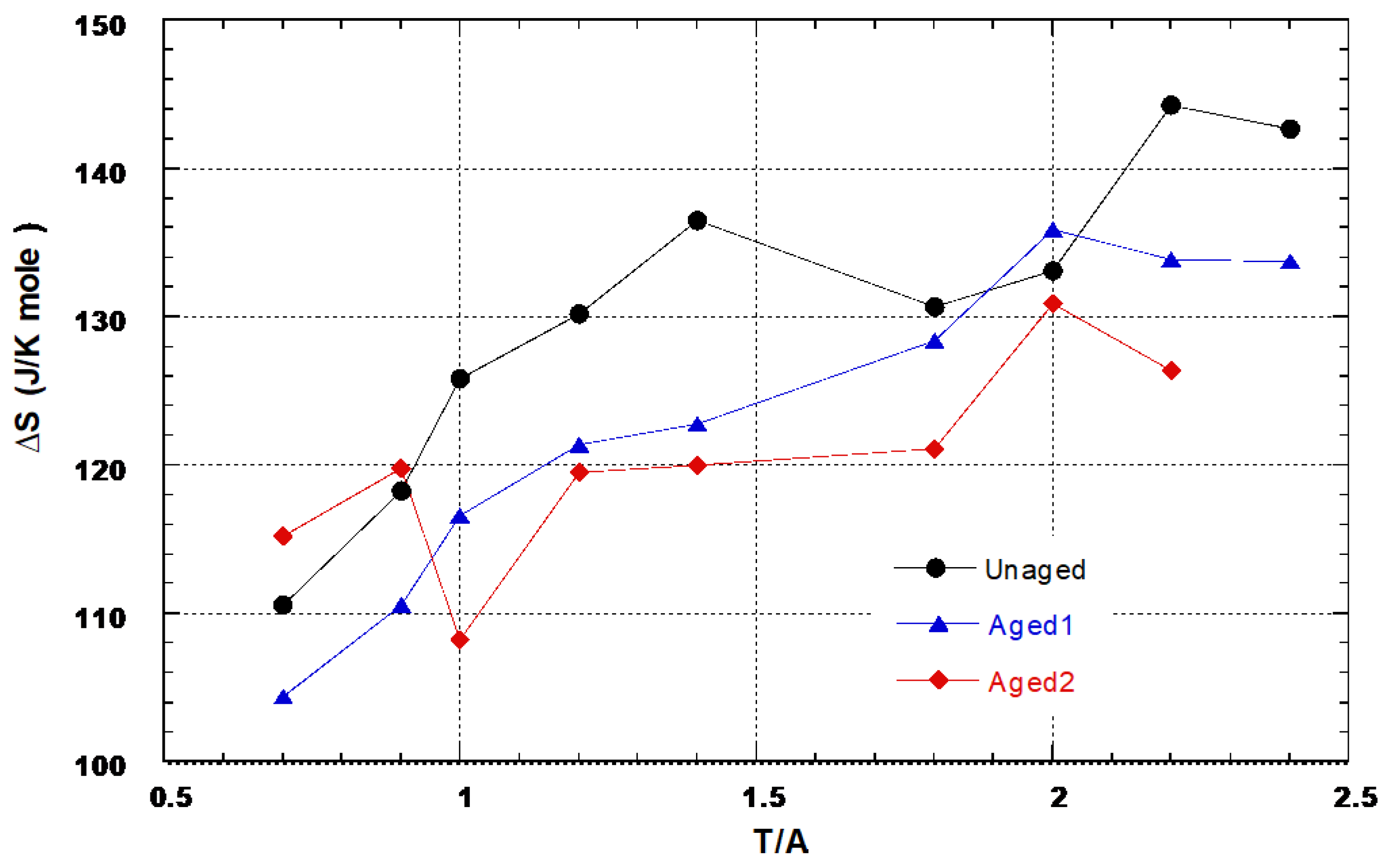
| Element | % by Weight |
|---|---|
| Zirconium | 45.38 |
| Vanadium | 27.2 |
| Iron | 23.75 |
| Chromium | 1.04 |
| Aluminium | 0.75 |
| Tin | 0.65 |
| Silicon | 0.33 |
| Manganese | 0.034 |
| Nickel | 0.017 |
| Niobium | <0.01 |
| Titanium | 0.006 |
| Copper | 0.0046 |
| Cadmium | <0.005 |
| Cobalt | 0.002 |
| T (K) | Xmax | Ks (at. Ratio/Pa1/2) | |
|---|---|---|---|
| H2 | 298 | 0.2 | 0.9153 |
| 323 | 0.3 | 0.3007 | |
| 373 | 0.5 | 0.1260 | |
| 423 | 0.5 | 0.04987 | |
| 473 | 0.5 | 0.02385 | |
| 523 | 0.5 | 0.01181 | |
| 573 | 0.3 | 0.007921 | |
| 623 | 0.5 | 0.00399 | |
| 673 | 0.5 | 0.002699 | |
| T2 | 373 | 0.97 | 0.07776 |
| 419 | 0.75 | 0.032507 | |
| 463 | 0.52 | 0.01526 | |
| 511 | 0.3 | 0.00796 | |
| 559 | 0.28 | 0.004057 | |
| 608 | 0.25 | 0.002396 |
| Q | (kJ/molQ) | (J/K molQ) |
|---|---|---|
| H | −26.98 | −55.91 |
| T | −27.97 | −62.61 |
| Q | xQ | −A | −B | kJ/mol Q | J/K mol Q | J/K mol Q |
|---|---|---|---|---|---|---|
| H | 0.075 | 3.5268 | 1452.3 | 27.79 | 19.65 | 55.98 |
| 0.1 | 3.577 | 1408.8 | 26.97 | 20.61 | 54.53 | |
| 0.2 | 3.81 | 1373.9 | 26.29 | 25.073 | 53.07 | |
| 0.3 | 4.273 | 1469 | 28.11 | 31.912 | 56.39 | |
| 0.5 | 4.4027 | 1446 | 27.67 | 36.42 | 56.35 | |
| Average | 27.36 ± 0.59 | 55.3 ± 1.97 | ||||
| T | 0.1 | 4.0123 | 1511.6 | 28.93 | 28.95 | 62.84 |
| 0.3 | 4.4913 | 1503.5 | 28.76 | 38.1129 | 62.59 | |
| 0.5 | 4.6863 | 1451.7 | 27.79 | 41.845 | 61.782 | |
| 0.75 | 4.8963 | 1463.2 | 28.005 | 45.865 | 62.0437 | |
| 0.95 | 5.1229 | 1492 | 28.55 | 50.2016 | 64.092 | |
| Average | 28.4 ± 0.41 | 62.68 ± 0.64 |
| Q | xQ | kJ/mol Q2 | J/K mol Q2 |
|---|---|---|---|
| H | 0.8 | 56 | 88.4 |
| 1 | 55.6 | 90.5 | |
| 1.4 | 60.7 | 110.1 | |
| 1.6 | 55.3 | 103.3 | |
| 1.8 | 55.9 | 108.6 | |
| 2 | 56.5 | 114 | |
| 2.2 | 54.1 | 115.4 | |
| 2.6 | 54.2 | 122.9 | |
| 2.8 | 51.3 | 122.4 | |
| Average | 55.5 ± 1.9 | 108.4 ± 5.5 | |
| T | 0.9 | 64.1 | 118.3 |
| 1.2 | 64.9 | 125.8 | |
| 1.4 | 64.7 | 130.2 | |
| 1.6 | 65.2 | 136.5 | |
| 1.8 | 60.5 | 130.7 | |
| 2.0 | 59.6 | 133.1 | |
| 2.2 | 61.3 | 144.3 | |
| Average | 62.9 ± 2.1 | 131.3 ± 5.7 |
(kJ/mol T) | (J/K mol T) | /R (J/K mol T) | |
|---|---|---|---|
| UR | 27.97 ± 0.7 | 62.61 ± 1.5 | 7.53 |
| Aged1 | 27.02 ± 1.1 | 59.38 ± 2.3 | 7.14 |
| Aged2 | 33.78 ± 0.6 | 66.3 ± 1.2 | 7.97 |
| (kJ/mol) | (J/K mol) | |||||
|---|---|---|---|---|---|---|
| T/A | Unaged | Aged1 | Aged2 | Unaged | Aged1 | Aged2 |
| 0.7 | 63.5 | 61.2 | 64.3 | 110.6 | 104.4 | 115.2 |
| 0.9 | 64.1 | 61.1 | 63.2 | 118.3 | 110.6 | 119.8 |
| 1 | 64.9 | 60.7 | 54.8 | 125.8 | 116.6 | 108.2 |
| 1.2 | 64.7 | 59.9 | 57.1 | 130.2 | 121.4 | 119.5 |
| 1.4 | 65.2 | 57.9 | 55.1 | 136.5 | 122.8 | 120 |
| 1.8 | 60.5 | 57.3 | 53.1 | 130.7 | 128.4 | 121.1 |
| 2 | 59.6 | 57.6 | 53.7 | 133.1 | 135.9 | 130.9 |
| 2.2 | 61.3 | 53.7 | 49 | 144.3 | 133.9 | 126.4 |
| 2.4 | 58.5 | 50.9 | 142.7 | 133.7 | ||
| Average | 62.9 ± 2.1 | 57.4 ± 2.6 | 55.2 ± 2.9 | 131.3 ± 5.7 | 125.4 ± 7.5 | 120.8 ± 4.5 |
Disclaimer/Publisher’s Note: The statements, opinions and data contained in all publications are solely those of the individual author(s) and contributor(s) and not of MDPI and/or the editor(s). MDPI and/or the editor(s) disclaim responsibility for any injury to people or property resulting from any ideas, methods, instructions or products referred to in the content. |
© 2024 by the authors. Licensee MDPI, Basel, Switzerland. This article is an open access article distributed under the terms and conditions of the Creative Commons Attribution (CC BY) license (https://creativecommons.org/licenses/by/4.0/).
Share and Cite
Ghezzi, F.; Shmayda, W.T. Aging Effects in Zr(Fe0.5V0.5)2 Tritides. Crystals 2024, 14, 159. https://doi.org/10.3390/cryst14020159
Ghezzi F, Shmayda WT. Aging Effects in Zr(Fe0.5V0.5)2 Tritides. Crystals. 2024; 14(2):159. https://doi.org/10.3390/cryst14020159
Chicago/Turabian StyleGhezzi, Francesco, and Walter Theodore Shmayda. 2024. "Aging Effects in Zr(Fe0.5V0.5)2 Tritides" Crystals 14, no. 2: 159. https://doi.org/10.3390/cryst14020159
APA StyleGhezzi, F., & Shmayda, W. T. (2024). Aging Effects in Zr(Fe0.5V0.5)2 Tritides. Crystals, 14(2), 159. https://doi.org/10.3390/cryst14020159








